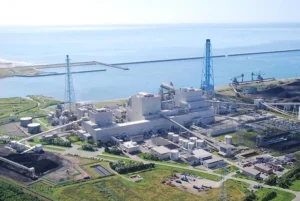Mitsubishi Heavy Industries, Ltd. (MHI; Tokyo) has received an order from Hokkaido Electric Power Co., Inc. (HEPCO) for the basic design of a CO2 capture plant (Front End Engineering Design, FEED) for the company’s Tomato-Atsuma Power Station. The plant will have the capacity to capture 5,200 tons of CO2 per day from the flue gases emitted during combustion of the boilers in the power station. For this FEED project, MHI will investigate the main equipment and specifications through MHI’s proprietary CO2 capture technology, in preparation for the introduction of equipment in the future. When completed, the facility is expected to be the largest CO2 capture plant in Japan.

Hokkaido Electric Power’s Tomato-Atsuma Power Station
(Photo Courtesy of Hokkaido Electric Power Co., Inc.)
HEPCO, in cooperation with Idemitsu Kosan Co., Ltd. and Japan Petroleum Exploration Co., Ltd., concluded a contract with Japan Organization for Metals and Energy Security (JOGMEC), a Japanese government Incorporated Administrative Agency, for the design work of a CCS(Note1) project in the Tomakomai area of Hokkaido, based on an open call for business consignment regarding “Engineering Design for Japanese Advanced CCS Projects.”(Note2) According to the agreement, the conception for the project is for CO2 captured at HEPCO’s Tomato-Atsuma Power Station to be stored in deep saline formations in the Tomakomai area, with the aim of storing approximately 1.5 million to 2 million tons of CO2 per year by 2030. Of note, Japan’s Ministry of Economy, Trade and Industry (METI) has selected a sea area near Tomakomai as Japan’s first “specified area” under the Act on Carbon Dioxide Storage Business (“CCS Business Act”), and exploratory drilling is currently being considered.
MHI Group has formally declared its commitment to achieving carbon neutrality by 2040 (MISSION NET ZERO), and the Company is now working strategically to decarbonize both the energy demand and supply sides. A core element of the Company’s “Energy Transition,” which targets decarbonization on the energy supply side, is the development of a carbon capture, utilization and storage (CCUS) value chain integrating diverse sources of carbon emissions with modes for carbon storage and utilization. Going forward, MHI Group will continue to proactively promote its CCUS business worldwide, applying its proprietary CO2 capture technologies, contributing as a solutions provider to reducing greenhouse gas emissions on a global scale, and developing further solutions that contribute to environmental protection.